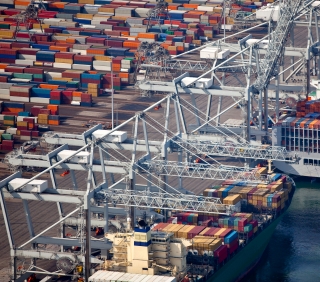 Shippers should not lose sleep over the recent, short-lived jump in spot rates, but ought instead to focus on ways to mitigate the risk of another sudden capacity crunch later in the year, London-based Drewry Maritime Research advised.
Shippers should not lose sleep over the recent, short-lived jump in spot rates, but ought instead to focus on ways to mitigate the risk of another sudden capacity crunch later in the year, London-based Drewry Maritime Research advised.
Freight rates on east-west trades have been rising of late. Drewry’s Hong Kong-Los Angeles container rate benchmark, as published in the Container Freight Rate Insight, leapt 28 percent in the first week of the year. The benchmark rose $396 to $1,832 per 40-foot equivalent unit (FEU) and successfully sustained this level into the second week.
Transpacific Stabilisation Agreement (TSA) carriers have been successful in forcing through their intended $400 per 40-foot-container rate increases.
Shipping lines have had similar success on the Asia-Europe trade. The World Container Index (WCI) benchmark rate between Shanghai and Rotterdam soared 41 percent in the first two weeks of January to $1,335 per FEU. The increase of $391 per FEU was in line with carriers’ intended peak season surcharge of $400 per FEU.
Buoyant shipping volumes in advance of Lunar New Year factory closures in Asia have filled ships to bursting, causing most carriers to roll containers. Some shipping lines have reported load factors in excess of 100 percent, so emboldening aggressive rate hikes.
“However, the big question on everyone’s minds is how sustained the rates revival will prove and what this means for 2012 transpacific contract rates?” asked Martin Dixon, research manager of Drewry’s Container Freight Rate Insight.
“Once the pre-Chinese New Year rush recedes later this month spot rates will retreat back to December levels, unless carriers take action to remove surplus capacity from the trade. Shippers would be well advised to wait a few weeks before commencing contract negotiations.”
Drewry expects freight rates to rise sharply in the second half of the year as cash-burn forces carriers to slash capacity.
“A repeat of 2010 seems inevitable, when freight rates rose and space availability was highly restricted,” added Dixon.
Prior to the recent bounce in pricing, east-west freight rates had been in free fall. Drewry’s East-West Freight Rate Index, a weighted average across key Asia-Europe, trans-pacific and trans-Atlantic trade routes, had declined 38 percent in the 12 months to November 2011.
However, other indices published in Drewry’s Container Freight Rate Insight suggest that some regions of the world have proved more stable than others. For instance, Drewry’s Intra-Asia Freight Rate Index lost just 6 percent through 2011 and gained 4 percent in the four months to November 2011.
“Few trades can claim this level of sustained stability,” observed Dixon. “Despite cascading tonnage from other overburdened trades, rates on Asian regional trades have remained remarkably stable thanks to burgeoning traffic growth.”




